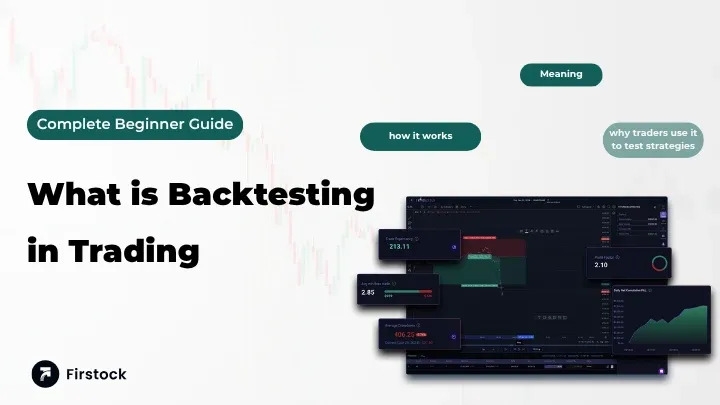What is Back Testing in Trading: A Complete Beginner’s Guide
Introduction
Have you ever wished you could travel back in time to test your trading ideas before putting real money on the line? That’s exactly what back testing in trading allows you to do — without a time machine! It’s like practicing on a cricket pitch before the actual match. Back testing lets traders evaluate their strategies using historical data to see how they might have performed in the past.
In this article, we’ll break down what is back testing in trading, how it works, the best back testing strategies, and even explore trading apps in India that help make it simple for beginners and pros alike.
Learn what is back testing in trading, top back testing strategies, and the best trading app in India for effective intraday analysis and performance testing.
What is Back Testing in Trading?
In simple terms, back testing is the process of testing a trading strategy using historical market data. The goal is to see how a particular strategy would have performed in the past if it had been applied during that time.
Imagine you’ve developed a rule that says, “Buy a stock when its 50-day moving average crosses above its 200-day moving average.” Back testing allows you to check how often this rule would have led to profits or losses over the last few years.
So, when you hear “back testing in trading,” think of it as a trial run for your trading idea — without financial risk.
Why Back Testing is Important for Traders
You wouldn’t drive a new car on the highway without testing it first, right? Similarly, you shouldn’t trade a new strategy in live markets without testing it. Here’s why back testing matters:
-
Identifies potential strengths and weaknesses of your strategy.
-
Reduces emotional decisions since you rely on data, not feelings.
-
Improves confidence in your approach.
-
Saves money by preventing real losses due to untested ideas.
In essence, back testing is your safety net before stepping into real trading conditions.
How Does Back Testing Work?
Back testing works by running your trading strategy on past market data. Here’s how it’s generally done:
-
Define your strategy – Example: Buy when RSI < 30, sell when RSI > 70.
-
Collect historical data – For example, daily price data of Nifty 50 for 5 years.
-
Run the strategy – Apply your rules to each historical period.
-
Analyze results – Check profit/loss, win rate, drawdown, etc.
Many trading apps in India now automate this entire process, so even beginners can back test strategies with just a few clicks.
Back Testing vs. Paper Trading
Although they sound similar, they serve different purposes.
| Aspect | Back Testing | Paper Trading |
| Data Used | Historical data | Live market data |
| Speed | Instant (past simulation) | Real-time |
| Risk | None | None |
| Goal | Evaluate a strategy’s past performance | Test performance in live conditions |
Think of back testing as watching past matches to plan your game, while paper trading is playing a practice match before the actual tournament.
Key Components of a Good Back Testing System
A robust back testing setup must include:
-
Accurate historical data – Wrong data means wrong results.
-
Clear trading rules – Define exact entry and exit conditions.
-
Realistic assumptions – Include transaction costs, slippage, and position size.
-
Performance metrics – Like profit factor, Sharpe ratio, and drawdown.
Without these components, your results might look better on paper than they would in reality.
Popular Back Testing Strategies
Here are some of the most common back testing strategies traders use:
a. Moving Average Crossovers
A simple yet effective approach — when the short-term moving average crosses above the long-term one, it signals a buy.
b. RSI Strategy
Buy when the Relative Strength Index (RSI) goes below 30 (oversold) and sell when it goes above 70 (overbought).
c. Breakout Strategy
Enter a trade when the price breaks above resistance or below support levels.
d. Mean Reversion Strategy
Assumes prices will return to their average over time. Buy when the price is significantly below the mean.
These strategies are great starting points for traders learning back testing in trading.
Advantages of Back Testing
Back testing offers several key benefits:
-
Data-driven insights – Removes guesswork.
-
Improved strategy development – Helps refine your trading rules.
-
Confidence boost – Seeing positive historical results gives you faith in your plan.
-
Performance tracking – You can easily compare different strategies.
In short, back testing makes trading more scientific and less emotional.
Common Mistakes Traders Make While Back Testing
Even experienced traders make errors. Here are the top ones to avoid:
-
Overfitting: Making your strategy too perfect for past data that it fails in the future.
-
Ignoring transaction costs: Small fees can eat into profits.
-
Using limited data: Testing only 1 year of data gives incomplete insights.
-
Bias in testing: Tweaking strategies just to get “good-looking” results.
Remember, the goal of back testing in trading is realistic accuracy, not perfection.
Real-World Example: Back Testing a Moving Average Strategy
Let’s take an example to understand better:
-
Stock: Reliance Industries
-
Strategy: Buy when 50-day MA crosses above 200-day MA, sell when it crosses below.
-
Period: 2015–2024
After back testing, you might find that the strategy gave 65% profitable trades with a 12% annual return. That’s useful data — it helps you decide if the strategy is worth using or needs refinement.
Tools and Software for Back Testing
Some popular global tools include:
-
TradingView – Easy to use, visual back testing.
-
MetaTrader 4/5 – Excellent for Forex and algorithmic testing.
-
Amibroker – Favored by technical analysts.
-
QuantConnect – Great for Python-based algorithmic trading.
Best Trading Apps in India for Back Testing
India offers several great platforms that support back testing in trading:
-
Zerodha Streak: A user-friendly app that allows no-code back testing.
-
Fyers One: Offers deep data analysis for back testing strategies.
-
Upstox Pro: Has built-in charting tools for historical testing.
-
Dhan: Offers algorithmic strategy testing with live data.
-
Alice Blue ANT: Ideal for both beginners and advanced users.
These trading apps in India make back testing accessible even for new traders.
How to Interpret Back Testing Results
When analyzing results, focus on:
-
Win rate: Percentage of profitable trades.
-
Drawdown: How much your portfolio might fall during bad periods.
-
Profit factor: Ratio of gross profit to gross loss.
-
Sharpe ratio: Risk-adjusted return measure.
Understanding these helps you judge whether a strategy is worth deploying in real markets.
Limitations of Back Testing
While back testing is powerful, it isn’t foolproof:
-
Past performance ≠ future results.
-
Market conditions change over time.
-
Execution issues like slippage can affect live performance.
So, always combine back testing with real-world testing (like paper trading) before risking real money.
Tips for Effective Back Testing
Here are some golden rules:
-
Use at least 5–10 years of data.
-
Include transaction costs and slippage.
-
Avoid curve-fitting.
-
Validate your strategy with forward testing.
-
Keep it simple. Overly complex strategies often fail in real conditions.
Remember: the goal of back testing is consistency, not perfection.
Conclusion
Back testing is like your trading laboratory — where ideas are tested, refined, and perfected before going live. It helps traders make informed decisions, manage risk, and develop confidence.
With powerful trading apps in India, you can easily perform back testing even without coding skills. So before you jump into the markets, take a step back, test your plan, and let history guide your next trade.
FAQs on Back Testing in Trading
1. What is back testing in trading?
Back testing in trading is the process of testing a strategy using historical data to estimate how it might have performed in the past.
2. What are the best back testing strategies?
Popular strategies include moving average crossovers, RSI strategies, breakout trading, and mean reversion techniques.
3. Can I back test using a trading app in India?
Yes! Platforms like Zerodha Streak, Fyers, Dhan, and Upstox allow easy back testing for Indian markets.
4. Is back testing reliable?
It’s reliable if done correctly with accurate data and realistic assumptions — but remember, past performance doesn’t guarantee future success.
5. What’s the difference between back testing and paper trading?
Back testing uses historical data to test strategies instantly, while paper trading uses real-time data to simulate trades without risking money.







